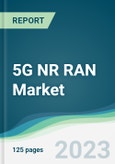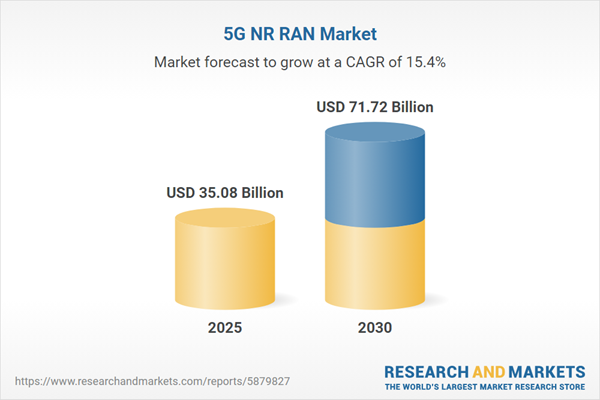Some of the factors driving the global 5G NR RAN market growth include key organizations placing more emphasis on research and development activities and the growing demand for low-latency bandwidth connections. Additionally, the market will grow during the forecast period due to the strong deployment of a 5G radio access network (RAN) with numerous small cells and macrocell base stations worldwide.
To lower overall infrastructure costs and network complexity, mobile network operators (MNOs) and network service providers are rapidly adopting centralized RAN and virtual RAN (VRAN). Additionally, the RAN allows businesses and mobile network providers using private 4G or private 5G to provide network-slicing solutions. These solutions allocate resources to specific businesses so that they can divide network usage within a public mobile network. Due to users' preference for 5G RAN solutions and technological advancements, the industry is growing at an incredible rate.
Further, the industry participants are forming strategic alliances and working together to expand the market for their goods and services and their availability across a range of geographies. For instance, in June 2023, Intel Corporation announced their strategic agreement with Telefonaktiebolaget LM Ericsson and Hewlett Packard Enterprise Development LP. The companies planned to utilize Intel vRAN Boost technology to demonstrate Ericsson's Cloud RAN solution on 4th generation Intel Xeon Scalable processors.
5G NR RAN Market Drivers
Booming 5G Deployment
The rise in popularity of modern communication networks has resulted in a faster pace of enabling 5G technology deployment with a growing demand for high-speed bandwidth. Large countries are making investments in network construction and are starting the necessary plans. As a result, rising expenditures for 5G technology are also evident. In October 2023, the Minister of Innovation, Science and Industry, as a way of supporting 5G deployment in rural areas, announced 'The Spectrum Outlook 2023 to 2027'. Meanwhile, the 3,800 MHz auction took place in October 2023 as expected, marking it as the third to enable 5G.In 2028, 5G is expected to outpace other forms of mobile access technologies in terms of subscriptions. Nearly 5.6 billion subscriptions are projected by 2029, which will represent 60% of all mobile subscriptions. Projections show that North America will account for approximately 90% of 5G penetration by 2029; while Gulf Cooperation Council (GCC) will rank second at 89% and Western Europe will occupy the third spot at 86%.
Moreover,NR RAN helps manage resources across radio locations and offers low latency with seamless connectivity, mobility, and optimal network security. The growing 5G deployment is expected to increase demand for RANs. Thus, it creates a connection between the user's devices, like laptopsand smartphones, and the main network, eliminating superfluous network complexity that would slow down internet speed.
5G NR RAN Market Geographical Outlook
Geography-wise, the market of 5G NR RAN is divided into the Americas, Europe Middle East and Africa, and Asia-Pacific. The increasing demand for modern communication networks and high-speed bandwidth are major reasons for boosting the market in the projected period. Additionally, the rising investment in the 5G technology market is expected to boost the market growth. For instance, in September 2023, the U.S. National Science Foundation (NSF) announced an investment of US$25 million in advanced technologies and communication to operate securely through 5G networks.Strategic partnership and collaboration among the 5G NR RAN players in the United States NR RAN market are expected to propel the market growth in the projected period. For instance, in December 2023, AT&T, headquartered in Dallas, Texas, collaborated with Ericsson to accelerate open and interoperable RAN in the United States. This collaboration aims at building a more robust ecosystem of network infrastructure providers, and suppliers. This project could roughly cost around US$14 billion over the 5-year term.
Additionally, the growing 5G deployment is a major market driver, as NR RAN helps provide low latency with smooth mobility, connectivity, and ultimate network security. For instance, according to the Cellular Telephone Industries Association (CTIA), in 2022, there were nearly 162 million active 5G devices which was almost double compared to 2021. 5G devices make up 1/3 of the total connections in the US, and by 2028, 91% of the total wireless connections are expected to be 5G. Hence, such increasing 5G penetration in the country is expected to positively impact the 5G NR RAN market in the projected period.
Reasons for buying this report:
- Insightful Analysis: Gain detailed market insights covering major as well as emerging geographical regions, focusing on customer segments, government policies and socio-economic factors, consumer preferences, industry verticals, other sub-segments.
- Competitive Landscape: Understand the strategic maneuvers employed by key players globally to understand possible market penetration with the correct strategy.
- Market Drivers & Future Trends: Explore the dynamic factors and pivotal market trends and how they will shape up future market developments.
- Actionable Recommendations: Utilize the insights to exercise strategic decision to uncover new business streams and revenues in a dynamic environment.
- Caters to a Wide Audience: Beneficial and cost-effective for startups, research institutions, consultants, SMEs, and large enterprises.
What do businesses use our reports for?
Industry and Market Insights, Opportunity Assessment, Product Demand Forecasting, Market Entry Strategy, Geographical Expansion, Capital Investment Decisions, Regulatory Framework & Implications, New Product Development, Competitive IntelligenceReport Coverage:
- Historical data & forecasts from 2022 to 2030
- Growth Opportunities, Challenges, Supply Chain Outlook, Regulatory Framework, Customer Behaviour, and Trend Analysis
- Competitive Positioning, Strategies, and Market Share Analysis
- Revenue Growth and Forecast Assessment of segments and regions including countries
- Company Profiling (Strategies, Products, Financial Information, and Key Developments among others)
The 5G NR RAN market is segmented and analyzed as follows:
By Technology
- Massive MIMO
- Non-Massive MIMO
By Spectrum Band
- Sub-6-Ghz
- mmWave
By Architecture
- Centralized RAN
- Virtual RAN
- Open RAN
By Deployment
- Standalone
- Non-Standalone
By Geography
- Americas
- By Technology
- By Spectrum Band
- By Architecture
- By Deployment
- By Country
- United States
- Others
- Europe, Middle East and Africa
- By Technology
- By Spectrum Band
- By Architecture
- By Deployment
- By Country
- Germany
- United Kingdom
- Others
- Asia-Pacific
- By Technology
- By Spectrum Band
- By Architecture
- By Deployment
- By Country
- China
- Japan
- South Korea
- Others
Table of Contents
Companies Mentioned
- Fujitsu
- Samsung
- Telefonaktiebolaget LM Ericsson
- Huawei Technologies Co., Ltd.
- Qualcomm Technologies
- Nokia
- Mavenir (Mitel Networks Corporation)
- Cisco
- NEC Corporation
- Airspan
- Intel
- Verizon
- Rakuten Symphony Singapore Pte. Ltd.
- Broadcom
Table Information
| Report Attribute | Details |
|---|---|
| No. of Pages | 136 |
| Published | December 2024 |
| Forecast Period | 2025 - 2030 |
| Estimated Market Value ( USD | $ 35.08 Billion |
| Forecasted Market Value ( USD | $ 71.72 Billion |
| Compound Annual Growth Rate | 15.3% |
| Regions Covered | Global |
| No. of Companies Mentioned | 14 |









